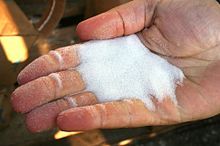Glass bead bow
A glass bead sheet , also rainbow of glass beads or rainbow with glass beads called ( English glass bead bow ), an optical phenomenon by which light refraction in or on glass beads which a sheet or in a point-like light source annular ring of spectral generated. It is mainly used to illustrate the rainbow in school lessons.
effect
In the case of spherical glass particles made of transparent glass, a ray of light undergoes a refraction at the point of entry into the sphere (transition from air to glass), which splits the light into spectral colors, a partial reflection at the opposite transition from glass to air and again a light refraction at the exit from the Glass ball (transition from glass to air). For the calculation, the formulas for the main rainbow can be used, where the density of glass was used. When lighting from a point-like light source such as the sun or a spotlight , a glass bead arch is created.
The glass bead arch is similar to the rainbow. The calculation is also easily transferable. Due to the higher density of the glass compared to water in the rainbow, however, it only forms a visible arc / ring in spectral colors. The color sequence is identical to that of a main rainbow. Red outside, purple inside. Inside the glass bead arch the surface appears lighter, while outside the arch it is darker. The normal main rainbow also separates the inner light area from a dark area called Alexander's dark band . A second glass bead arch does not form.
history
The reflection of light rays in glass or crystal balls has long been used to illustrate the reflections in a drop of water. In the High Middle Ages, Dietrich von Freiberg explored the rainbow with crystals and water droplets, including a sphere made of transparent crystal. Later researchers worked with round - bottom flasks filled with water . Depending on the type of glass and its refractive index , an incident light beam leaves the glass ball in different directions. A special form are retroreflectors in lens construction , which reflect the light back to where it came from. A bit longer knows one reflective beads for road markings that will reflect the light of car headlights in the eyes of the occupants of the car. Their diameter is about 0.4 mm to 1.5 mm. They are applied as a sprinkling agent and, when they are on the dark asphalt, show a glass bead arch. However, pearls with different refractive indices are mixed so that the individual spectral colors cannot be clearly defined.
By developing fine glass bead blasting material ( grain size below 400 micrometers) for glass bead blasting as an alternative to sandblasting , it was possible to generate ring-shaped light spectra with little effort and expense. To do this, you can throw the glass beads into the air or let them trickle down, distribute them on a surface or even glue them on, as long as the transition from glass to adhesive enables partial reflection. Since then, black plates with a thin layer of glass bead blasted material have been used to illustrate the rainbow , its dependence on the viewing position and other rainbow effects in the context of school lessons.
Web links
- Planet Schule - The walkable rainbow (approx. 8 x 4 meters, TV excerpt available online until May 7, 2023)
- LightSearcher - glass bead arch in diverging light 09.01.2010
- LightSearcher - Glass Bead Arch, June 27, 2010
Individual evidence
- ↑ a b c d e f g Thomas Wilhelm, Markus Horz, Hans-Joachim Schlichting: A rainbow with glass beads . In: Practice of Natural Sciences - Physics in School . tape 63 , no. 6 , 2014, ISSN 1617-5689 , p. 5–10 ( thomas-wilhelm.net [PDF; 622 kB ; accessed on August 10, 2020]).
- ↑ a b c d Alexander Haussmann: Observation and simulation of the glass bead arc in divergent light . In: Arbeitskreis Meteore eV (Ed.): Meteoros . Vol. 11, No. 9 , 2008, ISSN 1435-0424 , p. 165–170 ( meteoros.de [PDF; 2.5 MB ; accessed on August 10, 2020]).
- ↑ a b Manuel Walser: Rainbow . (Discovery learning; For teachers in schools) (= ETH Zurich - ETH Competence Center for Teaching and Learning - EducETH [Hrsg.]: Physics teaching materials ). February 1, 2007 ( ethz.ch [PDF; 2.1 MB ; accessed on August 17, 2020]).
- ^ A b Reiner Keller: O-91 - Rainbow on glass balls: main arch and surplus arches. In: vorsam.uni-ulm.de. Lecture Collection Physics - Ulm University - Online Archive, August 31, 2013, accessed on August 10, 2020 .
- ↑ Johannes Lohne: Rainbow and refractive index . In: Sudhoff's archive for the history of medicine and the natural sciences . tape 49 , no. 4 . Franz Steiner Verlag, December 1965, ISSN 0365-2610 , p. 401-415 , JSTOR : 20775244 .
- ↑ a b Patent DE102008009574 : Method and device for determining the refractive index (the refractive index) of transparent spheres and pearls (e.g. made of glass and the like) from the angle of reflection. Registered on February 16, 2008 , published on August 20, 2009 , applicant: Stephan Laumer, inventor: Stephan Laumer (now extinct).
- ↑ Reflective bead for road marking. In: sigmund-lindner.com. Sigmund Lindner GmbH, August 2, 2018, accessed on August 10, 2020 .
